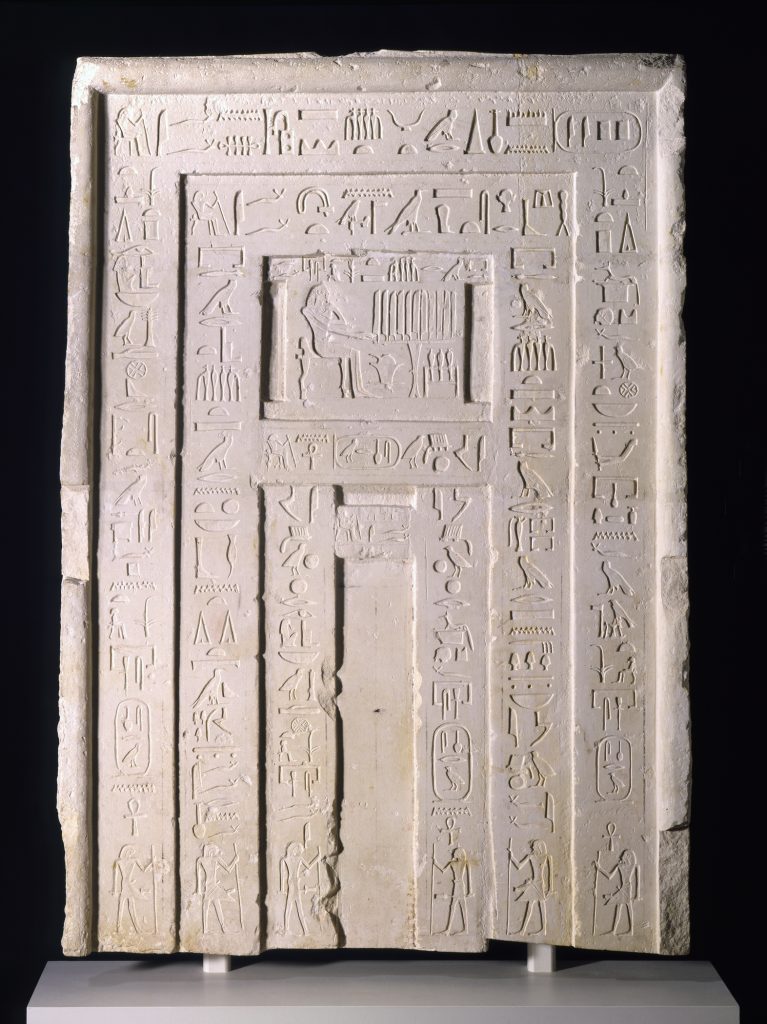False Door of Ni-ankh-Snefru (Called Fefi) (work of art)
Artwork Info
About
Key Ideas
- A false door does not open into another space. False doors can be carved into a wall or painted on it. They are a common architectural element in the tombs of ancient Egypt.
- These doors served as a passageway for the ka, or soul, of the deceased to travel between this world and the next. Offerings would be placed at the door by a visiting priest or family member, or the writing on the door would act as an offering.
- This door belonged to the courtier and nobleman Ni-ankh-Snefru, nicknamed Fefi. The hieroglyphic inscriptions on the door include Fefi’s name as well as many of the titles for which he is known, including priest, manager of wine and food storage at the palace, and overseer of a royal burial complex.
- There is a picture of Fefi near the center of the door, sitting in front of an offering table. At the bottom of the false door are figures representing Fefi. All of the figures are facing inward, as if they are approaching the door.
Learn More
The false door was an important architectural element of private tombs because it served as a passageway for the ka, or soul, of the deceased to travel between this world and the next. It was the centerpiece of the offering chapel, the accessible part of the tomb located above ground, where offerings were brought to the deceased. Carved in the shape of a door, including parts such as jambs, lintels, and even a rolled-up reed curtain above the doorway, this work of art is inscribed with offering formulas and, more important, the name and titles of its owner. This monument belonged to the nobleman Ni-ankh-Snefru, nicknamed Fefi.
Fefi listed his various titles in hieroglyphs, which included lector priest (one who recited sacred texts during religious rituals), overseer of the two “cool rooms” of the Great House (manager of the wine cellar and the food storage at the palace), and overseer of the pyramid complex Men-nefer-Pepy. This pyramid complex was the burial place of King Pepy I, located at Saqqara. Fefi was also a courtier, or person who attended the royal court. He took great pride in this fact, as it is mentioned six times in the inscriptions.
Fefi’s funerary arrangements would have included a contract with a ka priest, who would have been charged with bringing daily food offerings. The bread and beer placed in front of the false door would spiritually sustain Fefi’s ka for all eternity and, after the ceremony, would be given to the priest as payment for his services. Family and friends were also allowed to enter the chapel, provided they brought food and drink or recited offering formulas for Fefi’s benefit. Hieroglyphic inscriptions spiritually provided Fefi with offerings in case the priest or visitors failed to bring any.
tags: architecture, ancient Egypt, cycle, identity, meaning, ritual, survival
Additional Resources
Resources for Teachers
- Listen to NCMA curator Caroline Rocheleau talk about the False Door of Ni-ankh-Snefru.
- Fefi “wrote” a series of blog posts about hieroglyphs for the NCMA website. Read entries 1, 2, 3, 4, 5, and 6.
- Learn more about Egyptian false doors.
Resources for Students
- Listen to an NCMA curator explain the hieroglyphs on the False Door.
- Learn about the tombs of Egypt.
- Discover more about hieroglyphs.

